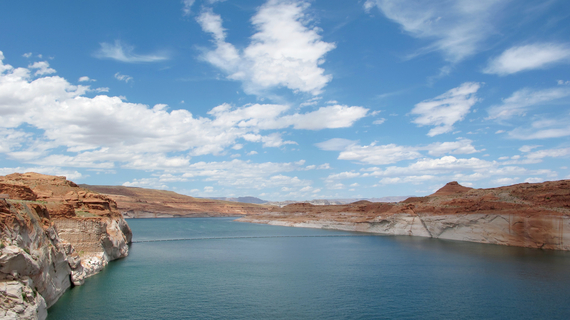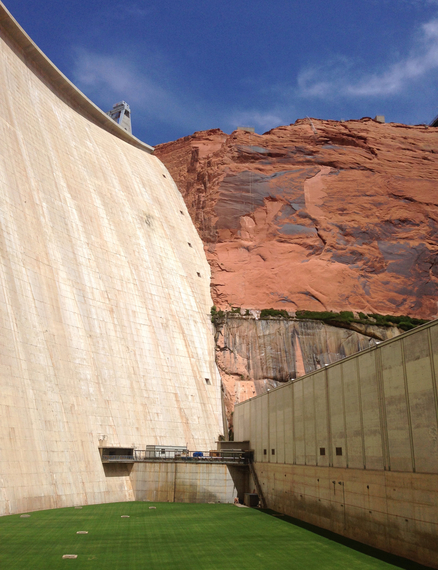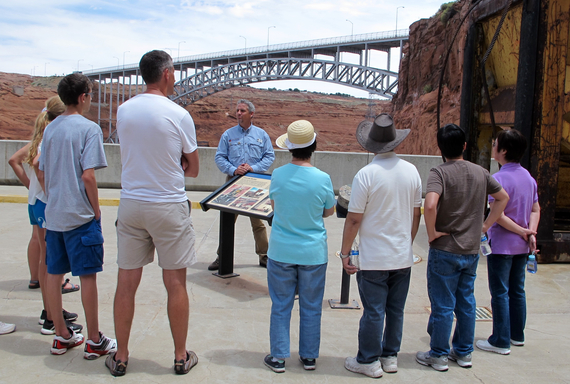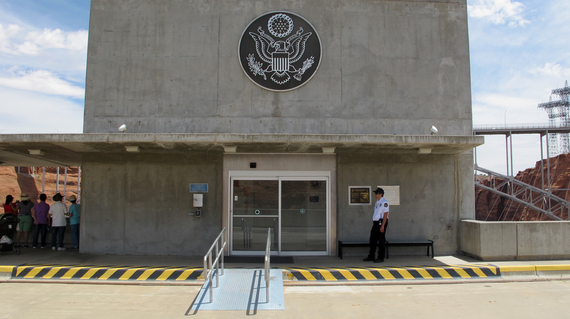
Edward Bennett, a Navajo rancher, in front of his water tank at the Shell Gas Station in Page, Arizona. With no running water for his family or his livestock, Bennett fills up the tank at least twice a day.
By Charlotte Weiner
PAGE, Arizona -- Edward Bennett only had to fill up his 400-gallon water tank once today.
It's just after 8 p.m., and as the light fades, heat leaves the desert air.
Bennett says that lately, the temperature has been hovering above 100 degrees at this time of night. On those days, he collects water from the Shell station on Haul Road twice, sometimes three times a day.
But, he says, it was not always this way.
"When I was growing up, we had water everywhere," Bennett says. Like the other ranchers in the westernmost section of the Navajo reservation that borders Page, Arizona, Bennett now hauls water from town for his livestock, and for his family, too. With no running water in his home, this is the water he uses to drink, cook, clean, bathe, and wash his clothes.
Bennett's voice is soft, and he speaks in clipped sentences that he preempts with an apology -- English is his second language. He grew up speaking Navajo and learned English in the Page public schools, but left school at 18 to start working at the coal-fired power plant a few miles east of town.
He worked at the Navajo Generating Station for 23 years, first doing menial jobs -- "pushing brooms, sweeping the floor, picking up trash, stuff like that" -- and then, for years, operating the mile-long train that hauled a hundred tons of coal from the mine to the plant three times a day. In 2000, the company started to lay off workers, including Bennett, as it transitioned from man to machine power. It was around then, Bennett says, that the groundwater around his land began to run dry.
Bennett rests his arms on a curve of paunch that a worn leather belt supports. Deep tracks of dirt run down the top of each leg, and the small of his back curves against the tank's metal grooves. He gives the container a tap. When he was younger, he says, "You didn't have to buy new water, or even a bottle of water."
But now, "Most of the springs, the mountain dews, the natural stuff, they're all dried up," Bennett says. "Everything is dry, you know?"
Just a mile west of where Bennett sits, though, one of the largest rivers in the United States flows.
If the founding principle of water law in the West -- first in time, first in right -- were universally followed, Bennett would be able to claim his rights to water from the Colorado River, which wraps around Page from the North and the West. The Navajo settled the land near Page in 1868, decades before competing users -- cities in Arizona, farmers and ranchers across the southwest, the power plant east of town -- ever claimed the water. But the tenet of water law that bases rights on seniority has thus far effectively excluded Native Americans.
When the seven states of the Colorado River basin gathered to allocate rights to the river in 1922, no Navajo representatives were invited to the deliberations. While the resulting Colorado River Compact acknowledged the existence of Native American claims to the river, it left their rights intentionally ambiguous and unquantified.
But as soon became clear, the roots of the Compact were fundamentally flawed. The Compact assumed that 18 million acre feet of water would flow through the Colorado each year. Since 1922, though, the river's average annual flow has been only 14 million acre feet. In hopes of guaranteeing access to their allocated water, the Upper Basin states met in 1956 -- again, without any Navajo present -- and authorized the creation of a series of dams that would store water and regulate the river's flow.
"It was just a small river, down there," Bennett says, and nods towards where the sun drops lower -- where, out of sight, the Colorado ran.
But the river is now unrecognizable. For the past 180 miles upstream, water has pooled and swirled and disappeared slowly under the sun's glare until it slides, in measured flows, through the second-largest dam in America.
Glen Canyon Dam, authorized in 1956 and completed nine years later, and Lake Powell, the reservoir behind it, provides not only water storage and regulation, but also power to the Southwest.
The hydropower plant at the dam's base produces energy for 5.8 million people -- although none of the five billion kilowatt hours of hydropower that it generates each year go to Bennett. Dozens of the homes around his still do not have electricity.

A nearly 100-foot high white-bleached "bathtub ring" marks where the water once rose at Lake Powell.
Powell stores 13 million acre-feet of water for release to Lake Mead, the reservoir behind Hoover Dam that feeds Phoenix and Las Vegas, among other cities. It also lies at the center of a $250 million dollar tourism industry -- restaurants and camping and marinas and boat tours and dam tours -- that now drives Page's economy.
But the lip of the lake is receding.
As over-allocation and drought take their toll, the reservoir has sunk to barely over half of its full capacity. Throughout the Colorado River Basin and along the length of the river itself, the impact of climate change is becoming increasingly clear. According to Bureau of Reclamation predictions, average runoff from the snowpack that fuels the river will fall by 8.5 percent by the middle of this century. By the end of the century, average temperatures in the Basin are projected to rise five to nine degrees Fahrenheit. The projected increase in temperatures alone would lead to a half-million acre-foot jump in water use.
Earlier this year at Lake Powell, which lies near the river's halfway point, water levels dropped 120 feet below full pool.
New beaches have emerged along the shore, stretches of brambles and soft sand, burnt red, where tourists flock. They set down their towels and float in water so thick with sediment that, when they wade in, their toes disappear in the water's haze before they are ankle deep.
The only two intakes into Powell draw water to the City of Page, and to the Navajo Generating Station, which uses over three-fifths of the water that has been set aside for Navajo use. The Navajo buy back their water from Page, which pumps, treats, recycles, and delivers the water to the gas station.
But with reservoir levels dropping and drought looming, Bennett is unsure about the future of Page -- and, along with it, his own future, too.
Bennett squints, habitually kneads his hands together as the light leeches out of the sky. "If they're gone, if something happens -" Bennett says, and his words carry a sense of inevitability. "We're all in the same boat."
***
The lake itself is a shock, almost surreal. Desert stretches out in every direction around Page, all red rocks and red dirt, tiny purple wildflowers by the highway and clumps of pale brush and flat landscapes that intersect the horizon. The expanse of the sky, a dome of pale blue, makes it seem impossible that anything could catch you off guard.
Heat rolls off the parking lot that leads up to Antelope Point Marina, a few minutes east of Page on the lake's south shore. At the far end of the lot, at the marina's end, the water finally comes into view -- improbably aqua, it glints in the light.
Three fountains pulse by the lookout point, halfheartedly pumping out water that splashes to the ground and runs in streams over the asphalt. Families cool off in the water. They have come from Belgium and France, Phoenix, Hong Kong, Holland, and Switzerland.
A boy, maybe sixteen, waits for his family in the shade, a few steps from the marina's end. He's about to go out onto Powell.
"Beautiful place, no?" he muses, and tugs on his black baseball cap. He wears a black wife-beater tank top and black sneakers. He's from Israel, but has just come from Las Vegas -- his family is travelling over "all of this section."
When he hears that there used to be no town here, no lake either, that the lake is, in fact, a reservoir where a river once flowed, he squints a bit, and nods, impressed. "Yes. It's awesome," he says, brightly.
"I've been to a lot of countries, and I've seen nothing like this." He looks back out at the lake, at the boats anchored and the 86-foot pale bathtub ring that marks where Powell once rose. "It's wonderful," he says, and gets up to join his parents, who have already left to head down the boardwalk to the lake.
***
Dan Beard admits that he sees Lake Powell far differently than tourists do. "When I look at it, I see the result of a monumentally bad decision," Beard says.
Beard, now retired, served for three years as the Commissioner of the Bureau of Reclamation. It was Beard's predecessor, Floyd Dominy, who, a half-century ago, pushed for the creation of Glen Canyon Dam.

The view from the base of Glen Canyon Dam. Behind the 710-foot wall of concrete lies Lake Powell, the second-largest reservoir in America.
Now, Beard spends his days advocating for the dam's destruction.
"When we build a structure, we determine that it's permanent. But dams deteriorate with age. They fill with silt. They are no longer needed in many cases," Beard says. "That's the case with Glen Canyon."
He says that the reasons for building the structure -- storage, power revenue, and tourism -- have already, or will soon, become obsolete.
"You go through every reason for why we built the structure, and you kind of come up empty," Beard says.
Beard says that the increase in heat will continue to drain Powell and make storage and power production less and less viable. The lake, he says, only further damages the river: already, over 860,000 acre-feet of water evaporate off of Powell's surface each year.
"Climate change is going to have a significant and very rapid impact on this system," Beard says. "It's kind of sad to see really smart people sitting there, saying, 'Oh, we don't need to change anything.' But this is like a freight train coming down the track. Change is coming. It's inevitable. So they better wake up, and start thinking."
But it is these same forces of global change that some argue make the dam, and Powell, more necessary than ever.
Like many climate scientists, Forrest Melton hasn't quite reconciled himself with the fact that he spends his days studying, researching, and producing work that many still vehemently resist.
A senior research scientist at the NASA Ames Research Center Cooperative for Research in Earth Science and Technology in California, Melton says that the "funny thing" -- in a voice that suggests that he finds little about this truly amusing -- is that many of the predicted impacts of climate change that he had studied at Stanford in the mid-1990s are now becoming true. The accelerating loss of snowpack and glaciers, melting permafrost, the increased frequency of extreme climate events -- droughts, floods, and more -- it's all happening.
"If I were a financial analyst who, twenty years ago, had been able to predict these major trends, and say, 'Oh, yeah, these things will happen,' you'd be kicking yourself for not buying those stocks or investing in that portfolio, right?" Melton says. "But when the climate science community nails it? It's, 'Oh, well, that's luck.'" He pauses, gathers himself. "Anyway. So."
While, from Beard's perspective, climate change will undermine Glen Canyon Dam's relevance, Melton says that, in fact, the opposite may be true.
"Climate change will increase our overall dependence on dams and other water capture infrastructure," Melton says. "It makes the risks, the potential downsides of removing a dam even higher, if you are also trying to find ways to ensure the water supplies for agriculture, and residential, and industrial use."
While the trends in terms of precipitation for the Colorado River Basin vary from model to model, all climate models show an increase in temperature -- somewhere from five to nine degrees Fahrenheit -- by the end of the century.
Even if precipitation remained the same, the increased temperatures would mean that, instead of snow and accompanying snowpack, which serves as a natural reservoir that slowly releases water into the Colorado over the course of the year, rainwater would drench the system at points. Meanwhile, in dry stretches, practically no natural reserves would remain.
Melton says that dams will serve as "key buffering points in the system" to capture and store excess runoff. "Dams will play an important role, unfortunately."
"Why would you destroy -" he backs up, tries to temper his words. "Why would ruin this incredible river?" he asks. "Well, you have cities full of people, and millions of acres of agriculture that are now dependent on that water."
Then, he checks himself, and adds, carefully: "It becomes difficult to find a mechanism that would be equally effective at ensuring water supplies across a range of climate conditions."
***
Four-hundred miles northwest of Page, in Boulder, Colorado, Gary Wockner walks in familiar strides along a riverbed. It rained last night, and Boulder Creek, fifty miles from the Colorado's headwaters in the Rocky Mountains, froths a bit where it runs over rocks on the shore. Wockner raises his voice to talk over the water's rush.
"People don't want to actually destroy rivers, even though they do it for a living," Wockner says. "It's just that in places like the West, where it's very dry, there's always a conflict."
Wockner, an environmental advocate and head of Save the Colorado, spends his days organizing resistance to new dams and diversions, and fighting to take down dams that already exist. He wears a boyish grey hoodie and leans in a little too close when he talks. Dulled urgency laces his words.
"It's a strange person that tries to protect rivers in the southwestern United States," Wockner says.
He admits that, in some ways, his fight is likely futile, and that he knows that politics, money, power -- "almost everything" -- are aligned against his work.
Wockner would have Glen Canyon removed, and would restore the river to its unrestricted flow. But he paraphrased David Brower, who led the Sierra Club in the heyday of the environmental movement a half-century ago: "In our line of work, every victory is temporary, and every defeat is permanent."
Wockner pauses, and says, unapologetically: "Am I depressing you?"
According to Wockner, after Hoover Dam's construction in the 1930s, with Glen Canyon Dam following, "The concept of dams, and river destruction, was then transported across the entire planet."
To restore rivers to their free-flowing state not only in the West but also on a global scale, Wockner argues that action must stem from work along the Colorado.
He digs the toe of his boat shoe into the damp dirt on the river's edge, and soil clings to the sole. When Wockner thinks of Glen Canyon, and the dams that have transformed the Colorado, his eyes narrow, arms cross. "It's the genesis of planetary river destruction," he says.
***
Midway through the guided tour of the root of planetary river destruction, no water is in sight. Instead, an arching, seven hundred foot wall of concrete rises. Streaks of salt and rainwater run down its bare face. As even Beard had admitted, it is "pretty spectacular."
At Glen Canyon Dam's base, below the wall of nine and a half million tons of concrete, a two-acre expanse of finely manicured, vibrant lawn rests, improbably resplendent. The tour guide says that water from Lake Powell irrigates the grass.
Inside, past two sliding glass doors, the hydropower plant's generators silently whir. The closest ones are immobile, but, halfway down the atrium, a main axel blurs.
Posters that line the opposite wall glowingly describe the creation of the plant, and detail hydropower's generation. A diorama, waist-level and no bigger than a square foot, stands at the end of the line of posters.
Inside the case, American flag cutouts ring a small Statue of Liberty replica, and a string of unlit Christmas lights winds around the flags. In the backdrop rests a Bureau of Reclamation logo carved in the shape of a water drop. Below it, a label reads, in cursive, 'Life, Liberty, and the Pursuit of Happiness.'
The accompanying poster promises: 'Now, with the flick of a switch, electricity can be used in your home.'

A display in the atrium of Glen Canyon Dam's hydropower plant promises: 'Now, with the flick of a switch, electricity can be used in your home.' Several miles away, on the Navajo reservation, many homes still do not have electricity.
Seven floors up, the tour group had looked down at the lawn from the top of the dam. From up there, the river was visible -- deep navy, almost black, and forest green around the edges where it flowed from the dam's base.
Someone had asked if there were any Native American sites buried under the lake.
Without a beat, the tour guide said, "I guess all sites were probably of cultural significance."
He described Rainbow Bridge, an arch that was partially submerged when Powell rose to full capacity. A huge boulder covered with hundreds of petroglyphs. The Crossing of the Fathers, the path that Spanish priests traversed and documented in the first ever passage of the Canyon in 1776.
"That's now at the bottom of Lake Powell," he said, and took a breath. "Okay. Great questions!"

A tour group at Glen Canyon Dam, at the head of Lake Powell. The dam and the lake it created are at the center of a $250 million dollar tourism industry in Page, Arizona.
Upstairs, in the main atrium of the visitor's center, another line of posters detail the construction of the dam. Against a blue background, white text: "Flowing through this area for millions of years, it cut Glen Canyon from the sandstone crust of the plateau." Then, on the next panel: "From here man would regulate the mighty river's flow to provide a steady source of water for irrigation, domestic use, industry, and to generate electricity."
***
It was not until several years ago, though, that many members of the LeChee chapter of the Navajo tribe that Wilford Lane helps to govern had a "steady source" of water for their homes.
Lane, who is in his early 70s, remembers when almost no one lived around Page. It was quiet, desolate. The first thing that changed was the road. "We used to hear dynamite going off," Lane says. "There is a big cliff, a big cliff they call Echo Cliffs, and they built a road right through it."
Soon, people started moving in. "They came in from that dirt road," Lane says, and traces his finger slowly down a map that he's spread across his desk. Lane came out of retirement several years ago to serve as the Chapter Manager for the LeChee Navajo chapter. The chapter had been working to bring electricity to 17 homes, but Lane's predecessor left in the middle of the project. Now, Lane has brought electricity to 63 families.
"Once I get that done, all of this chapter will be electrified. The next thing I'm working on is the water line," Lane says. He wears a black button down and black pants, and his hair, jet black at the roots, has begun to fade to a silvery white. His voice is slightly hoarse, and he speaks deliberately, unhurried; he'll finish a sentence, fall silent for a stretch so long it feels as if he is testing you, and then nod, and continue.
"Water was always the issue, when I was growing up," Lane says. "But summer monsoons would fill the dry ponds, and that's where we would water our livestock, our sheep, cows." He says that the ponds would last until November, when the snow came; the snow would last until February or March. Then the rains would come again.
Windmills that dot the landscape pump water from the aquifers below his land, and they still pull water that helps in dry stretches. "We can pump water from the ground, as much as we want, but some day I guess the aquifers is going to go dry," Lane says. "So how much of this water, how much of this lake can we use?"
He says that, growing up, water was always a problem. "But we weren't always thinking about water rights, at that time," Lane says. "In the later years, we learned about the water rights issue, and that's when it became a concern." The issue -- that the government granted the Navajo an unspecified and unquantified amount of water -- is only now beginning to be addressed. Lane says that, with water becoming scarcer downstream, legal fights over rights to the Colorado are being adjudicated. Soon, they will turn upstream, to the Navajo.
He has submitted a proposal to the Navajo Nation to add another intake into Powell; the project would also necessitate upgrading the water treatment facilities. All told, it would cost $10 million dollars, a price tag that makes Lane doubt the proposal's approval.
Neither Lane, nor anyone else in the tribe, knows how to quantify their claim to the river. So, for now, they rely on Page.
But the water they haul isn't enough to fill basic necessities. "We don't have enough water for fire hydrants," Lane says. "There are very few of them in the community. There isn't enough pressure for them to work." Lane will continue his push to bring running water to the remaining homes. In the meanwhile, they will continue hauling water, and hoping for rain.

